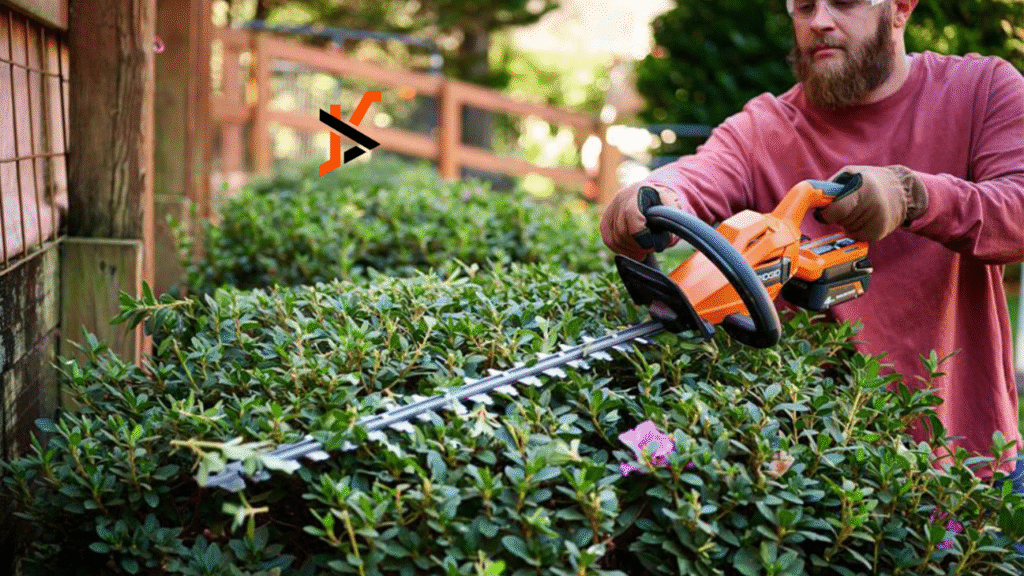Yes — a chainsaw can be used to cut bushes, especially when dealing with thick, woody stems or overgrown shrubs. However, shears or hedge trimmers are often the safer and more accurate choice for shaping hedges or achieving precise, even cuts. Many homeowners face the same dilemma: they want to save time and effort, but also want to avoid damaging their plants or risking injury.
In this article, we’ll walk you through when it makes sense to use a chainsaw, when to choose alternative tools, and how to select the correct type for bush work. You’ll learn safe cutting techniques, step-by-step instructions for trimming efficiently, and practical tips for keeping your bushes and chainsaw in top condition. We’ll also cover common mistakes to avoid and how to prevent plant damage while working.
When To Use A Chainsaw For Bushes
Thick Or Overgrown Branches
For stems 2–4 inches thick, a chainsaw saves significant time and effort compared to manual pruning tools.
Clearing Neglected Or Dense Shrubs
Ideal for removing woody growth that’s developed after years without maintenance.
Speeding Up Full Removal
Perfect for clearing bushes entirely when redoing landscaping or preparing for new planting.
When Not To Use A Chainsaw For Bushes
Delicate Shaping And Detail Work
Chainsaws are not designed for precision — use hedge trimmers or shears for neat, decorative shaping.
Small, Thin Stems
Thin branches can tear and splinter under a chainsaw, causing plant damage.
Near Hidden Obstacles
Avoid chainsaw use near rocks, wires, or fencing that could damage the chain or cause kickback.
Choosing The Right Chainsaw For Bush Work
Mini Chainsaws
Lightweight and easy to maneuver — great for most bush-cutting jobs.
Small Electric Chainsaws
Quiet, low-maintenance, and perfect for residential landscaping.
Pole Saws
Allow you to cut taller bushes or reach deep areas without bending or overreaching.
Step-By-Step Guide To Cutting Bushes Safely
Step 1 – Prepare Your Workspace
- Remove tools, debris, and trip hazards.
- Identify hidden obstacles in the bush.
Step 2 – Gear Up For Safety
- Gloves, safety glasses, ear protection, and sturdy boots are a must.
- Wear snug-fitting clothing to avoid chain snags.
Step 3 – Inspect And Prepare Your Chainsaw
- Check chain tension and sharpness.
- Ensure bar and chain lubrication.
Step 4 – Use Proper Cutting Technique
- Hold the saw with both hands.
- Make short, controlled cuts rather than long sweeps.
- Cut above a growth node to promote healthy regrowth.
If you’re looking for a reliable Mini Chainsaw for bush trimming, Seesii offers a range of cordless models designed for both home gardeners and professional landscapers. Their tools combine portability with impressive cutting power, making them ideal for tackling thick branches or overgrown shrubs. With ergonomic designs and long-lasting batteries, you can work comfortably and efficiently without being tethered to a power outlet.
Step 5 – Manage Debris And Clean Up
- Pause to remove branches from the work area.
- Clean the chainsaw after use to prevent sap buildup.
Risks And How To Avoid Them
Preventing Kickback
- Keep the chain tip away from hidden objects.
- Use a low-kickback chain when possible.
Avoiding Plant Damage
- Prune in stages to reduce plant stress.
- Avoid cutting in extreme heat or frost.
Reducing Fatigue And Improving Control
- Use a lightweight chainsaw.
- Work in short sessions with breaks.
Maintaining Your Chainsaw After Cutting Bushes
Clean Sap And Debris
Wipe down the bar and chain to prevent sticking and dulling.
Sharpen The Chain Regularly
Cutting small woody branches can dull a chain quickly.
Store Properly
Keep in a dry place with the battery removed (cordless) or fuel drained (gas).
Frequently Asked Questions
Can you cut bushes with a chainsaw?
Yes, but it’s best for thick, woody stems rather than fine shaping work.
Which chainsaw is best for bushes?
Mini chainsaws, small electric models, or pole saws offer better control for bush work.
Will a chainsaw damage my bushes?
It can if you cut too much at once or make rough cuts. Always cut in stages.
Do I need special maintenance after cutting bushes?
Yes — clean sap and debris off the chain, re-oil, and sharpen as needed.
When is the best time to cut bushes?
Generally, in late winter or early spring, before new growth, but check the needs of your specific plant.

